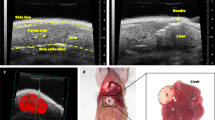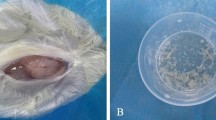Abstract
Background and aims
Metastatization, adhesion, invasion, and growth of tumor cells involve a cascade of complex phenomena which may be affected. We investigated the effect of a low molecular weight heparin, reviparin, on intra-abdominal tumor growth and intra-abdominal metastasis in rats undergoing laparoscopy.
Methods
CC531 adenocarcinoma cells (5×106 cells/ml) were administered intraperitoneally to 150 Wistar Albino Glaxo rats, with 15 groups of animals each. During laparoscopy 1 ml saline containing 0.0, 0.5, 2.0,; 4.0, and 10 mg reviparin/kg b.w. was introduced intraperitoneally (i.p.), daily subcutaneously (s.c.), or combined. After 21 days the animals were killed and underwent autopsy, and the tumor weight and the number of metastases on the liver surface were determined.
Results
Tumor weight was significantly reduced by 4.0 and 10.0 mg/kg b.w. but not by 0.5 or 2.0 mg/kg b.w. compared to controls. Decreased metastatization was observed in all treated groups. These effects were most pronounced after the s.c. or combined i.p. and s.c. administration, whereas after a sole i.p. administration only the highest dose of 10 mg/kg b.w. induced a significant inhibition of tumor growth.
Conclusion
Low molecular weight heparin given s.c. or in combination of i.p. lavage and s.c. injections significantly inhibits intra-abdominal tumor growth and intraperitoneal metastasis of CC531 adenocarcinoma cells in rats undergoing laparoscopy. This may offer additional therapeutic options for patients undergoing laparoscopic and also open cancer surgery.


Similar content being viewed by others
References
Neuhaus SJ, Ellis T, Jamieson GG, Watson DI (1999) Experimental study of the effect of intraperitoneal heparin on tumour implantation following laparoscopy. Br J Surg 86:400–404
Hermanek P, Wittekind C (1994) Inwieweit sind laparoskopische Verfahren in der onkologischen Chirurgie vertretbar? Chirurg 65:23–28
Jacobi CA, Peter FJ, Wenger FA, Ordemann J, ller JM (1999) New therapeutic strategies to avoid intra- and extraperitoneal metastases during laparoscopy: results of a tumor model in the rat. Dig Surg 16:393–399
Reymond MA, Schneider C, Kastl S, Hohenberger W, Kockerling F (1998) The pathogenesis of port-site recurrences. J Gastrointest Surg 2:406–414
Kockerling F, Reymond MA, Schneider C, Hohenberger W (1997) Fehler und Gefahren in der onkologischen laparoskopischen Chirurgie. Chirurg 68:215–224
Lee SW, Gleason NR, Bessler M, Whelan RL (1999) Peritoneal irrigation with povidone-iodine solution after laparoscopic-assisted splenectomy significantly decreases port-tumor recurrence in a murine model. Dis Colon Rectum 42:319–326
Pross M, Lippert H, Mantke R, Kruger S, Gunther T, Marusch F, Halangk W, Schulz HU (2001) A proteinase inhibitor decreases tumor growth in a laparoscopic rat model. Surg Endosc 15:882–885
Nagase H (1997) Activation mechanisms of matrix metalloproteinases. Biol Chem 378:151–160
Ghadimi BM, Schlag PM (1998) [Tumor metastasis. Molecular principles and therapeutic options]. Chirurg 69:1315–1322
Ghadimi BM, Behrens J, Hoffmann I, Haensch W, Birchmeier W, Schlag PM (1999) Immunohistological analysis of E-cadherin, alpha-, beta- and gamma-catenin expression in colorectal cancer: implications for cell adhesion and signaling. Eur J Cancer 35:60–65
Hejna M, Raderer M, Zielinski CC (1999) Inhibition of metastases by anticoagulants. J Natl Cancer Inst 91:22–36
Jacobi CA, Ordemann J, Bohm B, Zieren HU, Sabat R, Muller JM (1997) Inhibition of peritoneal tumor cell growth and implantation in laparoscopic surgery in a rat model. Am J Surg 174:359–363
Columbus Investigators (1997) Low-molecular-weight heparin in the treatment of patients with venous thromboembolism. N Engl J Med 337:657–662
Prandoni P, Lensing AW, Buller HR, Carta M, Cogo A, Vigo M, Casara D, Ruol A, ten Cate JW (1992) Comparison of subcutaneous low-molecular-weight heparin with intravenous standard heparin in proximal deep-vein thrombosis. Lancet 339:441–445
Jacobi CA, Peter FJ, Wenger FA, Ordemann J, Muller JM (1999) New therapeutic strategies to avoid intra- and extraperitoneal metastases during laparoscopy: results of a tumor model in the rat. Dig Surg 16:393–399
Tempelhoff GF von, Harenberg J, Niemann F, Hommel G, Kirkpatrick CJ, Heilmann L (2000) Effect of low molecular weight heparin (certoparin) versus unfractionated heparin on cancer survival following breast and pelvic cancer surgery: a prospective randomized double-blind trial. Int J Oncol 16:815–824
Martin MS, Martin F, Michiels R, Bastien H, Justrabo E, Bordes M, Viry B (1973) An experimental model for cancer of the colon and rectum. Intestinal carcinoma induced in the rat 1:2-dimethylhydrazine. Digestion 8:22–34
Zöller M, Matzku S (1999) Tumorprogression: Adhäsion, Proteolyse und Angiogenese. Chir Gastroenterol 15:128–136
See WA, Chapman PH (1987) Heparin prevention of tumor cell adherence and implantation on injured urothelial surfaces. J Urol 138:182–186
See WA (1993) Plasminogen activators: regulators of tumor cell adherence to sites of lower urinary tract surgical trauma. J Urol 150:1024–1029
Koopman MM, Prandoni P, Piovella F, Ockelford PA, Brandjes DP, van der MJ, Gallus AS, Simonneau G, Chesterman CH, Prins MH (1996) Treatment of venous thrombosis with intravenous unfractionated heparin administered in the hospital as compared with subcutaneous low-molecular-weight heparin administered at home. The Tasman Study Group. N Engl J Med 334:682–687
Pearlstone DB, Feig BW, Mansfield PF (1999) Port site recurrences after laparoscopy for malignant disease. Semin Surg Oncol 16:307–312
Acknowledgement
We thank Mrs. C. Jechorek for her technical assistance.
Author information
Authors and Affiliations
Corresponding author
Rights and permissions
About this article
Cite this article
Pross, M., Lippert, H., Nestler, G. et al. Effect of low molecular weight heparin on intra-abdominal metastasis in a laparoscopic experimental study. Int J Colorectal Dis 19, 143–146 (2004). https://doi.org/10.1007/s00384-003-0535-7
Accepted:
Published:
Issue Date:
DOI: https://doi.org/10.1007/s00384-003-0535-7




